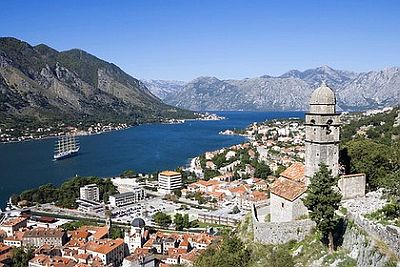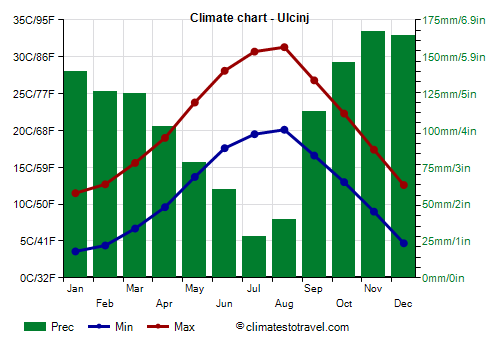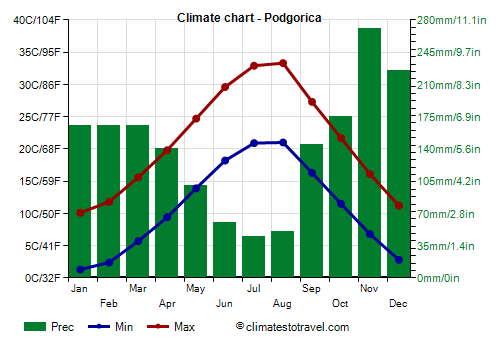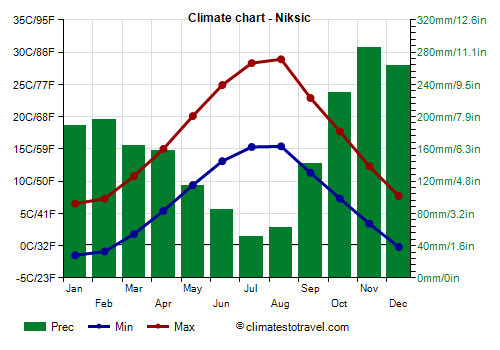Select units of measurement for the temperature and rainfall tables (metric or imperial).
Average weather, temperature, rainfall, sunshine
The climate of Montenegro is
Mediterranean on the coast, with heavy rains from September to April, while moving inland it becomes progressively more
continental, with colder winters, also due to the higher altitude.
Precipitation in Montenegro is plentiful, especially in the coastal strip and in hilly and mountainous regions overlooking the sea. The rains are not very frequent, but when it rains, it rains a lot. The rainy season is long and runs from September to April; sometimes, the rains are torrential.
Certain areas of Montenegro receive the highest amounts of rain of the entire European continent, on a par with some areas of Friuli, in northeastern Italy (see for example
Cetinje).
In addition, in inland areas and mountain ranges, additional rainfall occurs in the form of afternoon
thunderstorms in late spring and summer (more frequently in May and June).
On the contrary, on the coast and in Podgorica, at least rainfall decreases in summer, when thunderstorms are rare.
The climate in detail
Coast and plain
On the
coast, the climate is mild but rainy in autumn and winter, while in summer it's hot and sunny, though tempered by the breeze.
Winter is mild, with average temperatures in January around 9 °C (48 °F). However,
cold air masses of Russian origin may reach the coast, bringing a dry, down-slope wind which descends from the mountains and lowers the temperature down to the freezing point or even a little below. Typically, this wind does not bring snow, except in the limited areas where cold air manages to penetrate between the mountains.

The Bay of
Kotor is sheltered and mild, but in the cold season the temperature drops suddenly when the
Bura blows, a cold wind coming from the interior.
Ulcinj

In
Ulcinj, in the southern part of the coast, the average temperature ranges from around 7.5 °C (45.5 °F) in January to 25.5 °C (78 °F) in August.
Rainfall amounts to 1,250 millimeters (49.5 inches) per year, with a maximum from October to February and a minimum in July and August.
The
sea in Montenegro is warm enough for swimming from July to September, while it is a bit cool in June and October.
Podgorica

In the capital,
Podgorica, located at sea level but at some distance from the sea, the climate is still quite mild, but a little more continental than on the coast. So, winter is a bit cold, with an average in January of 5 °C (41 °F), while summer is hot and sunny, when days can be scorching. Heavy rains are possible from October to March.
In Podgorica, precipitation amounts to 1,700 mm (67 in) per year.
On the coast and in Podgorica, the amount of sunshine is very good in summer, when the sky is usually clear, while in winter it is not very high, however, some clear days can occur even in this season.
Inland areas
Nikšic
 Nikšic
Nikšic, the country's second city, is located at 650 meters (2,100 feet) above sea level, and has a moderate continental climate. Winters are cold, with snowfalls and frosts during cold spells, while summers are generally pleasant, with highs around 28 °C (82 °F), but with possible hot days, during which the temperature goes above 30 °C (86 °F).
The hill areas are even more rainy than the coast. In Niksic, 2,000 mm (78 in) of rain fall per year. In winter, heavy snowfalls can sometimes occur.
In Nikšic and in the interior, the amount of sunshine is slightly lower than that of the coast.
Continuing inland, the climate is even colder, so that in the far north, on the border with Serbia (see
Bijelo Polje,
Pljevlja), at a given altitude, the temperature is similar to that of the Alps, and during the most intense cold waves, the temperature can drop to -25/-30 °C (-13/-22 °F).
In Montenegro, there are
mountains exceeding 2,000 meters (6,500 feet). The highest peak,
Zla Kolata, is located in the south-east at the border with Albania; it reaches 2,534 meters (8,314 feet) and is located in the group of the Prokletije (or Albanian Alps), which are part of the Dinaric Alps.
When to go
The best time to visit Montenegro goes
from May to September.
On the
coast, the
summer is a good season for a beach holiday, especially in July and August: the weather is sunny and hot, but tempered by the breeze. We cannot exclude some brief afternoon thunderstorms (as we have said, more rarely than in inland areas).
In
Podgorica, the summer can be uncomfortably hot, and the temperature can reach 40 °C (104 °F), especially in July and August, so you can choose the months of
May and September.
In
mountainous areas, thr summer is the best season. The sun often shines, even though there's some chance of thunderstorms in the afternoons.
What to pack
In
winter: in the inland region, bring warm clothes, a down jacket, a hat, a scarf, gloves, a raincoat or umbrella. In Podgorica and the coast: warm clothes, such as a sweater, a jacket, a raincoat or umbrella.
In
summer: in the inland region, bring light clothes, a T-shirt, but also long pants, a light jacket and a sweatshirt for the evening; an umbrella. In Podgorica and the coast: light clothing, and possibly a sweatshirt for the evening, especially in June.
Climate data - Montenegro
| Bar |
|---|
|
| Jan | Feb | Mar | Apr | May | Jun | Jul | Aug | Sep | Oct | Nov | Dec |
|---|
| Min temp. | 6 | 6 | 8 | 10 | 14 | 18 | 21 | 21 | 18 | 14 | 10 | 7 |
|---|
| Max temp. | 13 | 14 | 16 | 19 | 24 | 28 | 30 | 30 | 27 | 23 | 19 | 14 |
|---|
| Precip. | 140 | 130 | 130 | 110 | 80 | 55 | 30 | 45 | 135 | 150 | 165 | 180 |
|---|
| Prec. days | 10 | 10 | 9 | 9 | 7 | 4 | 3 | 3 | 6 | 9 | 10 | 12 |
|---|
|
| Day length | 10 | 11 | 12 | 13 | 15 | 15 | 15 | 14 | 12 | 11 | 10 | 9 |
|---|
| Sun hours | 4 | 4 | 6 | 7 | 8 | 10 | 11 | 10 | 8 | 6 | 4 | 4 |
|---|
| Sea temp | 14 | 14 | 14 | 15 | 18 | 21 | 24 | 25 | 23 | 20 | 17 | 15 |
|---|
| Berane (700 meters) |
|---|
|
| Jan | Feb | Mar | Apr | May | Jun | Jul | Aug | Sep | Oct | Nov | Dec |
|---|
| Min temp. | -5 | -4 | -1 | 3 | 7 | 10 | 12 | 11 | 8 | 4 | 0 | -3 |
|---|
| Max temp. | 4 | 7 | 11 | 16 | 21 | 25 | 27 | 28 | 23 | 18 | 11 | 5 |
|---|
| Precip. | 85 | 65 | 65 | 80 | 70 | 70 | 60 | 60 | 65 | 75 | 115 | 100 |
|---|
| Prec. days | 12 | 11 | 12 | 13 | 13 | 13 | 10 | 9 | 9 | 9 | 14 | 14 |
|---|
|
|
|
|
| Bijelo Polje (605 meters) |
|---|
|
| Jan | Feb | Mar | Apr | May | Jun | Jul | Aug | Sep | Oct | Nov | Dec |
|---|
| Min temp. | -4 | -3 | 0 | 4 | 9 | 12 | 14 | 14 | 10 | 6 | 2 | -2 |
|---|
| Max temp. | 5 | 8 | 13 | 18 | 22 | 26 | 28 | 29 | 24 | 18 | 12 | 5 |
|---|
| Precip. | 65 | 75 | 70 | 70 | 80 | 75 | 70 | 50 | 85 | 85 | 100 | 90 |
|---|
| Prec. days | 8 | 9 | 8 | 9 | 10 | 8 | 8 | 6 | 8 | 8 | 9 | 9 |
|---|
|
|
|
|
| Cetinje (650 meters) |
|---|
|
| Jan | Feb | Mar | Apr | May | Jun | Jul | Aug | Sep | Oct | Nov | Dec |
|---|
| Min temp. | -4 | -3 | 0 | 4 | 8 | 11 | 12 | 12 | 9 | 5 | 2 | -2 |
|---|
| Max temp. | 7 | 8 | 11 | 15 | 20 | 25 | 28 | 28 | 23 | 18 | 12 | 8 |
|---|
| Precip. | 430 | 350 | 370 | 275 | 155 | 100 | 65 | 110 | 190 | 295 | 500 | 455 |
|---|
| Prec. days | 13 | 13 | 14 | 13 | 11 | 10 | 7 | 7 | 7 | 11 | 15 | 15 |
|---|
|
| Day length | 10 | 11 | 12 | 13 | 15 | 15 | 15 | 14 | 12 | 11 | 10 | 9 |
|---|
|
|
| Herceg Novi |
|---|
|
| Jan | Feb | Mar | Apr | May | Jun | Jul | Aug | Sep | Oct | Nov | Dec |
|---|
| Min temp. | 5 | 5 | 7 | 10 | 14 | 18 | 20 | 21 | 17 | 13 | 10 | 6 |
|---|
| Max temp. | 13 | 14 | 16 | 19 | 24 | 28 | 31 | 32 | 27 | 22 | 18 | 14 |
|---|
| Precip. | 195 | 190 | 175 | 160 | 105 | 70 | 40 | 65 | 140 | 175 | 230 | 245 |
|---|
| Prec. days | 11 | 10 | 10 | 10 | 8 | 5 | 3 | 4 | 7 | 9 | 11 | 12 |
|---|
|
|
| Sun hours | 4 | 4 | 5 | 6 | 8 | 10 | 11 | 10 | 8 | 6 | 4 | 3 |
|---|
| Sea temp | 14 | 14 | 14 | 15 | 18 | 21 | 24 | 25 | 23 | 20 | 17 | 15 |
|---|
| Kolasin (945 meters) |
|---|
|
| Jan | Feb | Mar | Apr | May | Jun | Jul | Aug | Sep | Oct | Nov | Dec |
|---|
| Min temp. | -5 | -4 | -2 | 2 | 6 | 9 | 10 | 10 | 7 | 4 | 0 | -4 |
|---|
| Max temp. | 4 | 5 | 9 | 14 | 19 | 23 | 25 | 26 | 20 | 16 | 10 | 4 |
|---|
| Precip. | 185 | 190 | 185 | 165 | 135 | 95 | 75 | 60 | 165 | 220 | 300 | 275 |
|---|
| Prec. days | 12 | 12 | 12 | 12 | 13 | 9 | 8 | 6 | 9 | 10 | 12 | 13 |
|---|
|
|
| Sun hours | 3 | 3 | 4 | 5 | 6 | 6 | 8 | 8 | 6 | 5 | 3 | 2 |
|---|
|
| Kotor |
|---|
|
| Jan | Feb | Mar | Apr | May | Jun | Jul | Aug | Sep | Oct | Nov | Dec |
|---|
| Min temp. | 3 | 3 | 5 | 8 | 12 | 16 | 18 | 18 | 14 | 11 | 7 | 4 |
|---|
| Max temp. | 12 | 13 | 16 | 19 | 23 | 28 | 32 | 32 | 27 | 22 | 18 | 14 |
|---|
| Precip. | 145 | 140 | 125 | 115 | 85 | 65 | 40 | 55 | 115 | 140 | 180 | 185 |
|---|
| Prec. days | 13 | 13 | 12 | 12 | 9 | 7 | 5 | 5 | 7 | 9 | 14 | 14 |
|---|
|
|
| Sun hours | 4 | 4 | 5 | 6 | 8 | 10 | 11 | 10 | 8 | 6 | 4 | 3 |
|---|
| Sea temp | 14 | 14 | 14 | 15 | 18 | 21 | 24 | 25 | 23 | 20 | 17 | 15 |
|---|
| Niksic (645 meters) |
|---|
|
| Jan | Feb | Mar | Apr | May | Jun | Jul | Aug | Sep | Oct | Nov | Dec |
|---|
| Min temp. | -2 | -1 | 2 | 5 | 9 | 13 | 15 | 15 | 11 | 7 | 3 | 0 |
|---|
| Max temp. | 6 | 7 | 11 | 15 | 20 | 25 | 28 | 29 | 23 | 18 | 12 | 8 |
|---|
| Precip. | 190 | 195 | 165 | 155 | 115 | 85 | 50 | 65 | 140 | 230 | 285 | 265 |
|---|
| Prec. days | 10 | 10 | 9 | 10 | 10 | 8 | 6 | 6 | 8 | 9 | 11 | 12 |
|---|
|
|
| Sun hours | 4 | 4 | 5 | 6 | 7 | 8 | 10 | 9 | 8 | 6 | 4 | 3 |
|---|
|
| Pljevlja (785 meters) |
|---|
|
| Jan | Feb | Mar | Apr | May | Jun | Jul | Aug | Sep | Oct | Nov | Dec |
|---|
| Min temp. | -5 | -4 | -1 | 3 | 7 | 11 | 12 | 12 | 9 | 5 | 1 | -4 |
|---|
| Max temp. | 4 | 7 | 11 | 16 | 21 | 25 | 27 | 28 | 22 | 18 | 11 | 4 |
|---|
| Precip. | 45 | 60 | 55 | 65 | 75 | 80 | 75 | 55 | 70 | 70 | 75 | 65 |
|---|
| Prec. days | 8 | 8 | 8 | 10 | 11 | 10 | 8 | 7 | 8 | 8 | 8 | 9 |
|---|
| Humidity | 82% | 75% | 70% | 70% | 70% | 71% | 70% | 70% | 73% | 76% | 80% | 84% |
|---|
| Day length | 9 | 10 | 12 | 14 | 15 | 15 | 15 | 14 | 12 | 11 | 10 | 9 |
|---|
| Sun hours | 2 | 3 | 4 | 5 | 6 | 6 | 8 | 7 | 6 | 4 | 2 | 1 |
|---|
|
| Podgorica |
|---|
|
| Jan | Feb | Mar | Apr | May | Jun | Jul | Aug | Sep | Oct | Nov | Dec |
|---|
| Min temp. | 1 | 2 | 6 | 9 | 14 | 18 | 21 | 21 | 16 | 12 | 7 | 3 |
|---|
| Max temp. | 10 | 12 | 16 | 20 | 25 | 30 | 33 | 33 | 27 | 22 | 16 | 11 |
|---|
| Precip. | 165 | 165 | 165 | 140 | 100 | 60 | 45 | 50 | 145 | 175 | 270 | 225 |
|---|
| Prec. days | 10 | 10 | 9 | 10 | 8 | 6 | 4 | 4 | 7 | 9 | 11 | 11 |
|---|
| Humidity | 71% | 67% | 63% | 63% | 61% | 56% | 47% | 48% | 59% | 69% | 76% | 74% |
|---|
| Day length | 10 | 11 | 12 | 13 | 15 | 15 | 15 | 14 | 12 | 11 | 10 | 9 |
|---|
| Sun hours | 4 | 4 | 6 | 6 | 8 | 9 | 11 | 10 | 8 | 6 | 4 | 4 |
|---|
|
| Ulcinj |
|---|
|
| Jan | Feb | Mar | Apr | May | Jun | Jul | Aug | Sep | Oct | Nov | Dec |
|---|
| Min temp. | 4 | 4 | 7 | 10 | 14 | 18 | 20 | 20 | 17 | 13 | 9 | 5 |
|---|
| Max temp. | 12 | 13 | 16 | 19 | 24 | 28 | 31 | 31 | 27 | 22 | 17 | 13 |
|---|
| Precip. | 140 | 125 | 125 | 105 | 80 | 60 | 30 | 40 | 110 | 145 | 165 | 165 |
|---|
| Prec. days | 9 | 10 | 9 | 9 | 7 | 4 | 2 | 3 | 6 | 8 | 10 | 11 |
|---|
|
| Day length | 10 | 11 | 12 | 13 | 15 | 15 | 15 | 14 | 12 | 11 | 10 | 9 |
|---|
| Sun hours | 4 | 5 | 6 | 7 | 9 | 10 | 11 | 10 | 9 | 6 | 4 | 4 |
|---|
| Sea temp | 14 | 14 | 14 | 15 | 18 | 21 | 24 | 25 | 23 | 20 | 17 | 15 |
|---|
| Zabljak (1,450 meters) |
|---|
|
| Jan | Feb | Mar | Apr | May | Jun | Jul | Aug | Sep | Oct | Nov | Dec |
|---|
| Min temp. | -7 | -7 | -4 | 0 | 4 | 8 | 9 | 9 | 6 | 2 | -2 | -6 |
|---|
| Max temp. | 2 | 3 | 6 | 10 | 15 | 19 | 21 | 22 | 16 | 13 | 8 | 3 |
|---|
| Precip. | 115 | 130 | 125 | 115 | 110 | 90 | 75 | 60 | 115 | 175 | 215 | 185 |
|---|
| Prec. days | 10 | 11 | 11 | 12 | 13 | 11 | 9 | 8 | 10 | 10 | 12 | 13 |
|---|
|
|
| Sun hours | 3 | 3 | 4 | 5 | 6 | 7 | 8 | 8 | 7 | 5 | 4 | 3 |
|---|
|
See also the
temperatures month by month